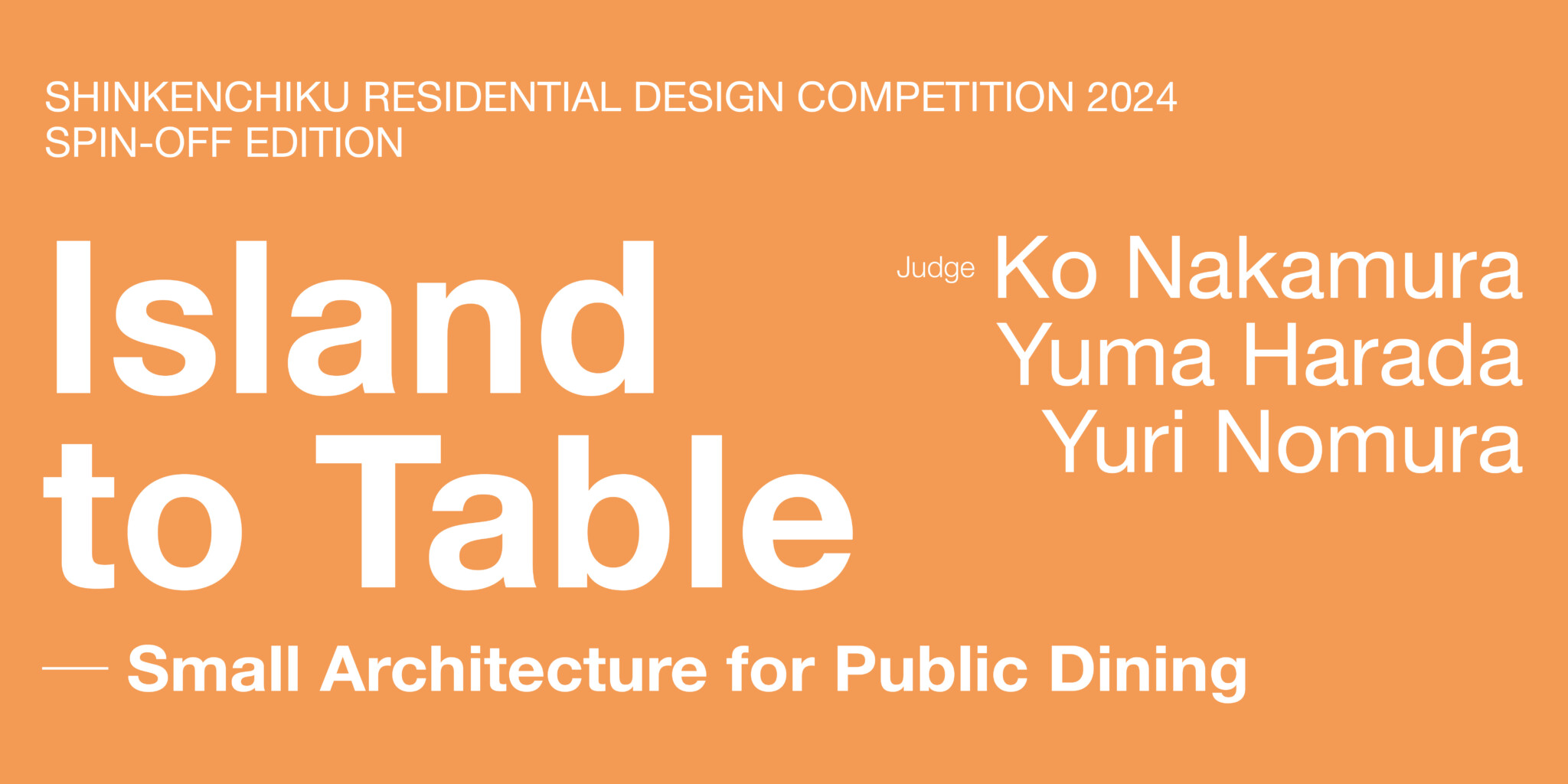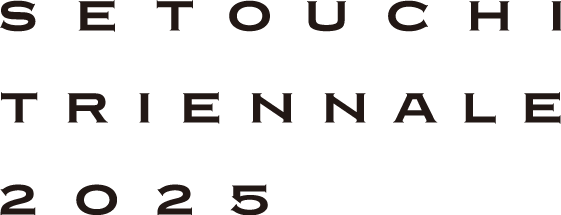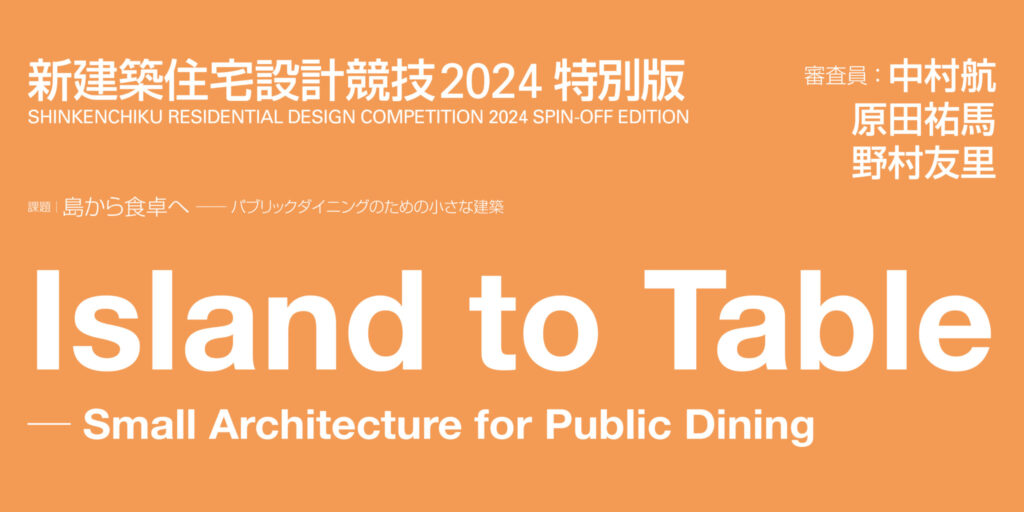Shinkenchiku Residential Design Competition 2024 Spin-off Edition Island to Table ─ Small Architecture for Public Dining
Today, food production, distribution, and consumption are intricately intertwined, and have become extremely globalized. Social conditions in distant countries and climate change have a major impact on the prices and supply stability of the ingredients that reach our dinner tables. At the same time, cuisine is strongly localized according to regional climate and culture, with diverse foods spreading from place to place.
The Japanese island regions have also played a role in supporting Japan’s food culture as production areas for a variety of ingredients. One such production areas is Shodoshima in the Setouchi Inland Sea, which is rich in natural resources. If we expand the concept of ”Farm to Table,” which brings production and consumption closer together, thus enjoying locally produced food, is it possible to think about “Island to Table”?
Shodoshima with its mild climate is abundant in local resources, such as olive and orange groves. The island, an important maritime transportation hub and scenic spot, attracts people from all over the world. Food has played an important role in the interaction between local residents and visitors. People with different backgrounds have formed friendships through food, for example, by preparing meals for pilgrims visiting sacred sites through osettai, or by creating cafeterias and food stalls where visitiors and local residents can gather, like in the recent Setouchi Triennale. Shodoshima’s food industry is also facing a shortage of workers and a decline in places to enjoy food?
The theme of this competition is to think of a new public dining space to inherit the rich food culture and production landscape spreading across the island and enjoy them from a mobile and minimal architecture.
This competition seeks ideas of small architecture for public dining in the Sakate Port area, located in the southeastern part of Shodoshima, where new port facilities are currently under construction.
Please propose a public dining in the Sakate Port area as a community space built around 3 food trucks under 5 planning conditions, and assuming actual operation and opening of a restaurant.
We look forward to new architectural proposals that emerge from a local perspective under the theme of food.
Prize
- WinnerMultiple¥1,000,000
The number of winners and the amount of prize money will be determined by the judge.
Schedule
- 2024.06.01 (土)Registration opens
- 2024.08.31 (土)Registration closed
- 2025.02.01 (土)Announcement of the winner
Guidelines
Planning Condition
Condition 1:
Any format of the food truck is acceptable, but please assume a vehicle that can be driven with a regular driver's license, considering the traffic conditions on the island and the need to move to other areas for business.Condition 2:
In order to actually serve food and drinks, please be sure to include cooking utensils, sinks, refrigeration equipment, water tanks, etc. that have been approved by the public health center, and take precautions to prevent the intrusion of dust and insects. Please be noted that uncooked food such as raw fish is not possible to provide, only heat-cooked food before serving is allowed.Condition 3:
3 food trucks shall be built, and the scenery should be that of a gathering at a base in Sakate Port area. In addition, each of them may go to different areas of the island.Condition 4:
Please propose specifically about the content you provide, such as the island's production, harvest, ingredients, cooking methods, and menus along with the architecture. We expect an integrated proposal for space and content that will enrich life on the island and at the same time increase attention to the island from around the world.Condition 5:
We look for new innovative proposals, but please also consider the balance with the feasibility of actually producing and operating them. Regardless of the results of the competition, we may ask you to participate in a project we are currently planning on Shodoshima (the proposal may be changed depending on regulations, budget, etc.).Building Site
Shodoshima Sakate Port Area
The Sakate Port area, which is currently being redeveloped as a tourist center and new port facilities are under construction, will be the target site.Location: Sakate, Shodoshima-cho, Shodo-gun, Kagawa
Target Site DataEntry and Application
To enter the competition, please first register on the competition website. A registration number will be issued by email after the registration form is properly completed. Each applicant should keep a record of this registration number, as it will be needed for submitting your proposal. Re-registration is required if there is any change in the registered personal information. Also, if the applicant wishes to submit multiple proposals, it is necessary to obtain a registration number for each one.
・No inquiries regarding the registration number will be accepted once the number has been issued.
・Registration is available only through the competition website.
・Use of mobile phone email addresses is not recommended as there might be problems in receiving the registration number.Submission Requirements
Contents: Site plan, floor plan, elevation, section, perspective drawing, and axonometric drawing at any scale. You are free to include model photographs, detailed drawings, and other diagrams. Your submission should include a descriptive text of your design no more than 250 words in English, or 600 characters in Japanese, in 12-point type or larger. All drawings, illustrations, and texts should be laid out on 2 sheets of A2 (420×594 mm / 16.5×23.5 inches). You may also embed external links.
・File format: PDF
・File size should not exceed 10MB (please combine 2 sheets in a single file)
・The registration number must be used as the name of the PDF file for each design entry (e.g., skc0000.pdf).Submission Procedure
Follow the application form at the URL specified in the pre-resistered email, and upload the applicant's information and files.
Please note the file size. Entries outside the regulations will not be considered for judging.Note: The number of emails right before the deadline may overwhelm our internet server, so please do not wait until the last minute to submit your entry. The competition hosts will take no responsibility for submissions that arrive late due to technical issues and will not judge any late submissions.
Announcement of Initial Screening Results
Early October 2024. In addition to notifying entrants who have passed, we will announce the results on the website.
Final Screening
November 2024 in Shodoshima. The final screening will be held publicly. After presentations of several entries that have passed, Q&A, and judging, recipients of the Grand Prize, Awards of Excellence, and Honorable Mentions will be decided then and there.
Announcement of the Winner
Winner(s) will be announced in the 2024 April issue of SHINKENCHIKU (published on April 1, 2024) and April issue of a+u (published on March 27, 2024), their digital issues, and on the competition website.
Notice
・Copyright of the proposal belongs to the applicant, while the publishing right belongs to Shinkenchiku-sha Co., Ltd.
・Submitted proposals, regardless of the result, may be published on the competition website.
・Questions regarding the competition regulations will not be answered by the hosts. All matters not covered in the regulations listed above are left to the discretion of the entrants.
・Proposals must not have been made public previously in any form. The work must not (in total or in part) infringe on anyone’s copyrights. Do not use images copied from magazines, books, or websites. If a copyright infringement is discovered, the prize may be rescinded at the host’s discretion.
・The winning entrants will be asked to submit high-resolution digital data for publication.
・All fees associated with submissions must be borne by entrants.
・When the second screening is held in Shodoshima, transportation expenses will be covered up to 50,000 Japanese yen per team.
・Please double-check the contents of your submission. You will not be allowed to replace your proposal after submission.
・Please avoid corrupted texts and broken links. Please embed all the linked files.
・Entries will only be accepted if they adhere to all the regulations.
Theme Roundtable Discussion
Coming soon...
Judge

Ko Nakamura
Ko Nakamura received B.Arch from Nihon University in 2002, M.Eng from Waseda University in 2005. After working at Waseda University as a research associate and researcher, he taught at Kengo Kuma Lab, the University of Tokyo as an assistant professor from 2010 to 2016. He received his PhD with research on street food trucks in Southeast Asian cities in 2011, and established his practice MOSAIC DESIGN afterwards. His recent works include COMMUNE, Falo, and PANORAMA HOUSE. He authored Pop Urbanism and KJ 2021 June “Mosaic Design.”
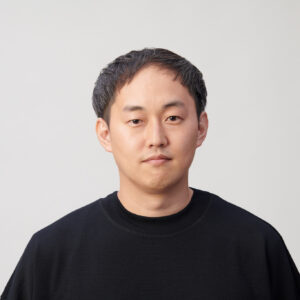
Yuma Harada
Yuma Harada graduated from the Faculty of Art Studies of Kyoto Seika University majoring in architecture in 2000, and went on to establish UMA/design farm in 2007. He is a visiting professor at Nagoya University of the Arts. Based in Osaka, he creates new experiences through graphics, exhibitions, planning, and the development of projects related to culture, welfare, and community, all while centering the philosophy of “Think Together, Make Together.”
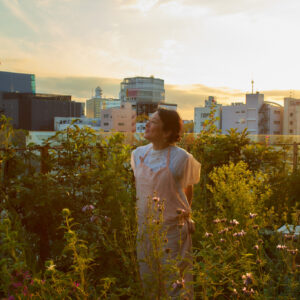
Yuri Nomura
Chef / President of eatrip, Yuri Nomura was inspired by her mother, who taught hospitality classes for many years, to pursue a career in the culinary arts. She has been expressing the possibilities of food in a wide variety of ways with directing food and catering, planning events, teaching, writing serial articles for magazines, and appearing in radio programs. Recently, she runs eatrip soil, a grocery shop and seed club, and is the author of Tobikiri de Delicious Ouchi-Gohan (2023).
